Ultraviolet Light and Its Effects on Minerals
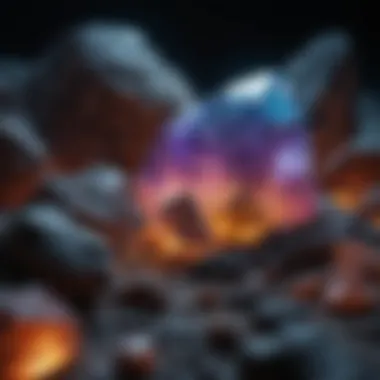

Intro
The allure of minerals isn't just in their physical beauty, but rather in what lies beneath their surface. One fascinating aspect of this exploration involves ultraviolet light—a tool often overlooked but crucial in revealing subtle features of minerals. This article embarks on a journey into how ultraviolet light influences minerals, emphasizing fluorescence, identification, and practical applications in fields like geology and mineralogy. By tapping into the interactions between UV light and specific mineral compositions, we can not only satisfy our curiosity but also deepen our understanding of Earth's hidden treasures.
"Ultraviolet light not only illuminates, but also transforms our understanding of minerals."
Those passionate about collecting rocks and fossils will find that the fluorescence of minerals under UV light opens up a world of patterns and properties that go beyond the naked eye. Whether you are a seasoned collector, an educator, or simply an enthusiastic hobbyist, grasping the relationship between ultraviolet light and minerals is an invitation to a richer experience with these natural wonders.
History and Origins
Overview of Collectibles, Rocks, and Fossils
Throughout history, humans have been intrigued by the natural world, particularly rocks and fossils. The quest to understand these items has led many to become collectors, fostering a rich tradition of appreciation and study. The advent of ultraviolet light in mineralogy brought about a significant shift in how collectors and scientists view these artifacts. While ordinary light can show only a fragment of a mineral's true character, UV light exposes additional layers of beauty, often akin to a hidden chapter in a well-thumbed book.
The journey of mineral collecting can be traced back to ancient civilizations who marveled at the earth’s gemstones and rocks. In modern times, the integration of technology, including the use of ultraviolet light, has transformed mineral and fossil collecting into a sophisticated endeavor.
Historical Significance and Cultural Impact
The historical significance of UV light in mineralogy is not merely a footnote. It has influenced cultures and scientific thought, prompting a deeper inquiry into the physical properties of gems and minerals. In ancient Egypt, for instance, lapis lazuli was revered for its vivid blue hue, but under UV light, it reveals unique fluorescent qualities. It is a testament to how light, in its various forms, can reshape our views. Each mineral holds its own story—one that can sometimes only be told through the magic of ultraviolet light.
Today, mineral enthusiasts often share their discoveries on platforms like Reddit or Facebook, using UV light as a common thread to connect with others who share similar interests. This communal aspect highlights the cultural impact of understanding minerals through UV light: it not only fosters a common language among collectors, but also breeds appreciation for the intricate geology that underpins our planet.
Identification and Classification
Guide to Identifying Rocks and Fossils
Identifying minerals and fossils can be likened to solving a puzzle, where each piece reveals a crucial fragment of information. Fluorescence under UV light not only enhances one’s ability to distinguish between similar minerals but also provides insight into their authenticity. For instance, some minerals exhibit distinctive colors under ultraviolet light that can guide collectors in their assessment.
To aid the identification process, one can refer to some key points:
- Color Response: Many minerals display unique colors that can indicate their mineral composition.
- Intensity of Fluorescence: The brightness can vary based on the mineral's purity and structure.
- Wavelength Spectrum: Different minerals react to UV light in unique ways.
By integrating these factors, collectors can enhance their identification skills, turning what might initially seem like a guesswork into an informed process rooted in science.
Common Types and Variations
When it comes to the interplay of uranium and minerals, it is significant to highlight common types that collectors encounter:
- Fluorite: Known for its vibrant colors, fluorite can glow brilliantly under UV light, making it a favorite among collectors.
- Calcite: This mineral can show a range of fluorescence, often depending on impurities present in its crystalline structure.
- Scheelite: This mineral's quick fluorescence is a distinct marker that can help identify it amongst others.
Each of these minerals tells a story of geological processes, but they come alive in a completely different way under UV light, giving them multidimensional character.
Whether it’s a casual stroll through a local nature reserve or an expedition to a renowned gemstone site, understanding how ultraviolet light interacts with minerals can elevate any mineralogical experience. It encourages a more holistic appreciation for not only the minerals themselves but also the environment they originated from.
Understanding Ultraviolet Light
Ultraviolet (UV) light sits just beyond the visible spectrum of light. While humans cannot see it, the effects of UV light can be profound, particularly in the realm of minerals. This segment emphasizes the essential characteristics of UV light, setting the stage for understanding its influence on mineral properties. The relationship between UV light and minerals can enhance our appreciation of Earth’s natural wonders, offering practical applications for collectors, educators, and researchers. Understanding UV light not only provides insights into the unique behaviors of various minerals but also enables better identification and classification in geological studies.
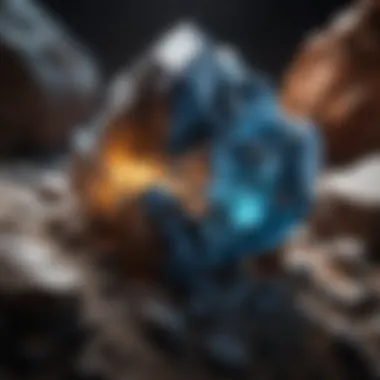
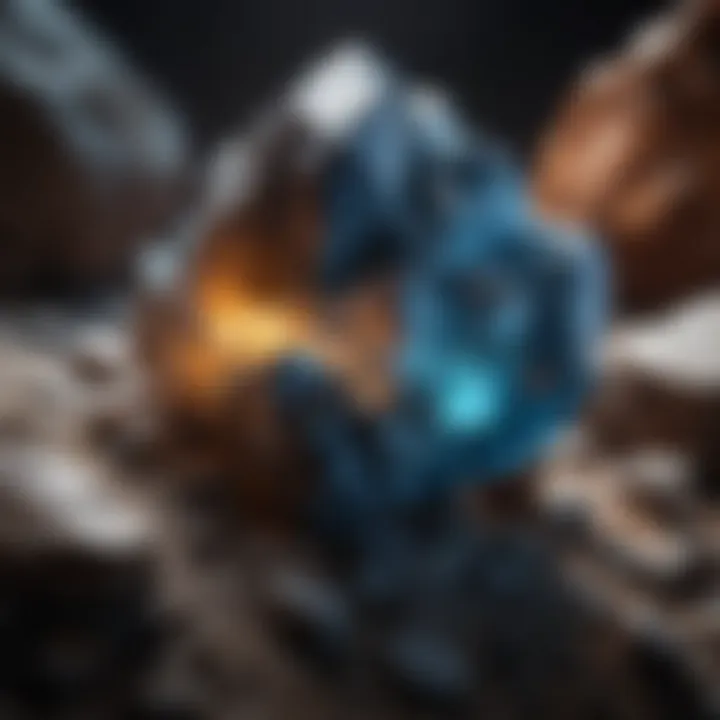
Definition and Characteristics
Ultraviolet light is electromagnetic radiation with wavelengths shorter than visible light but longer than X-rays. Typically, UV light falls within the 10 nm to 400 nm range. Its energy levels are higher than visible light, which is why it can induce various chemical reactions within some materials, including minerals. This may result in phenomena such as fluorescence or even permanent changes in the mineral properties. In essence, UV light serves as a gateway to unlocking hidden characteristics that would otherwise remain obscured under normal lighting.
Types of Ultraviolet Light
UVA
UVA rays, with wavelengths from 320 nm to 400 nm, are the most prevalent type of UV light. They penetrate deeper into materials and are often responsible for causing subtle fluorescence in minerals. A unique aspect of UVA is its capability to induce a range of visible emissions. This feature makes it a valuable tool for collectors, who utilize UVA light to spot interesting specimens more effectively. However, while UVA is more gentle compared to its UVB and UVC counterparts, it can still pose some health risks over extended exposure, particularly to human skin.
UVB
UVB light is situated between 280 nm to 320 nm and is known for its potential to cause damage to living tissues, including human skin. However, when it comes to mineral interactions, UVB may sometimes induce stronger fluorescence compared to UVA. The increased energy in UVB means that certain minerals react more intensely under this type of light. While advantageous for studying fluorescence, the downside is that higher UVB exposure can lead to irreversible changes in the samples. For mining enthusiasts, understanding how UVB influences mineral reactions can lead to better handling practices.
UVC
UVC rays, ranging from 100 nm to 280 nm, are the most energetic among UV types. Although natural sources of UVC are minimal since it’s absorbed by the Earth’s atmosphere, artificial sources such as certain types of lamps can emit UVC light. In mineralogy, UVC rays have facilitated research due to their capacity to induce significant fluorescence, albeit with caution being advised due to their potential harmful effects. UVC’s primary benefit is in controlled environments, where its use can showcase properties of rare minerals that might not be visible otherwise but comes at the cost of necessary protective measures to safeguard against exposure.
Sources of Ultraviolet Light
Natural Sources
The sun represents the most significant natural source of ultraviolet light, emitting a wide spectrum that includes UVA, UVB, and some UVC rays. Understanding that our primary light source radiates UV rays is vital for field researchers and collectors. Natural exposure affects not only mineral visibility but also the ecological interactions within ecosystems. Still, this reliance on sunlight can present limitations, mainly depending on geography and weather conditions.
Artificial Sources
In recent decades, various artificial sources of UV light have surfaced, offering the advantages of controlled environments for mineral observation. Devices such as UV lamps and fluorescent long-wave lights emulate sunlight’s properties, making it easier to examine mineral specimens indoors. This flexibility allows collectors to assess minerals at their leisure, providing consistent and repeatable results. However, the drawback of artificial sources is their dependency on electricity and the potential for equipment malfunction, which could disrupt valuable research or collection processes.
Fluorescence in Minerals
Fluorescence in minerals is an intriguing aspect of geology and mineralogy, revealing hidden characteristics that enhance our understanding of these natural wonders. This phenomenon occurs when certain minerals absorb ultraviolet light and then re-emit it as visible light, showcasing bright colors that are often invisible in regular lighting. Understanding fluorescence not only aids in identifying minerals but also enriches the experience of collectors, educators, and researchers alike.
Mechanism of Fluorescence
Fluorescence involves a complex interplay of photons and electrons within the mineral's structure. When ultraviolet light strikes a mineral, its energy is absorbed by the electrons, causing them to jump to a higher energy level. Once the electrons return to their original state, they release energy in the form of visible light. The colors emitted can vary greatly, depending on the chemical composition and impurities within the mineral. This process can be likened to a short dance: the energy bounces around before ultimately returning to its quiet state, leaving behind a dazzling glow.
Notable Fluorescent Minerals
A few minerals stand out in the world of fluorescence, each with unique characteristics that make them important to collectors and researchers.
Fluorite
Fluorite is one of the most well-known fluorescent minerals. Its vibrant hues can range from deep purple to bright green, depending on its impurities. The distinctive feature of fluorite is its ability to fluoresce in a variety of colors under UV light, often displaying multiple shades simultaneously. This peculiar quality makes fluorite not only a sought-after mineral among collectors but also a useful specimen in educational settings. However, fluorite can exhibit complexity when compared to other minerals as it can be sensitive to light exposure, causing it to lose its vivid hues over time if not properly cared for.
Smithsonite
Smithsonite, with its pastel shades of blue, green, and pink, has a unique charm. This carbonate mineral fluoresces predominantly in bright green tones when exposed to UV light. Smithsonite is particularly appreciated for its aesthetic appeal; collectors often prize it for the delicate color variations that can be found in it. One downside, however, is that while it fluoresces beautifully, its more fragile structure makes it less suitable for heavy handling or display than more robust minerals.
Calcite
Calcite displays some of the most remarkable fluorescent properties. Many forms of calcite can fluoresce a bright orange or yellow under UV light, providing a captivating visual experience. The significance of calcite in this context cannot be overstated; it plays a vital role in various geological processes, while its captivating fluorescence attracts mineralogists and collectors alike. However, the abundance of calcite may make it less unique in some collecting circles—it's not uncommon to find it in various forms across different regions.
Fluorescence in minerals not only enhances their visual appeal but also provides essential clues about their composition and conditions of formation. Understanding these properties is essential for both enthusiasts and professionals in the field.
Overall, fluorescence adds a layer of complexity and beauty to mineralogy, highlighting how ultraviolet light can reveal hidden qualities in these geological treasures.
Identifying Minerals with UV Light


The identification of minerals using ultraviolet (UV) light is a pivotal aspect of mineralogy that helps enthusiasts and geologists alike reveal the hidden dimensions of these geological specimens. The power of UV light to expose fluorescent properties in minerals adds an intriguing layer of discovery to the field of geology. Not only does this method enhance knowledge about mineral characteristics, but it also provides a visual feast that can be both informative and captivating.
Visual Indicators of Fluorescence
One of the most significant advantages of employing UV light in mineral identification is the visual indicators of fluorescence. When minerals are exposed to these specific wavelengths of light, they can exhibit brilliant colors that might not be observable under normal daylight conditions. For instance, Fluorite, a beloved specimen among collectors, might glow a stunning blue or green under UV light, while Calcite can show a variety of hues depending on its specific impurities.
The color and intensity of fluorescence can differ between samples, providing a unique fingerprint for identification. Collectors and researchers benefit greatly from knowing what to look for. This ability to see minerals in such a different light opens up discussions around the mineral’s chemical composition, crystallography, and other scientific facets.
Comparative Analysis of Minerals
Fluorescent vs. Non-Fluorescent Minerals
The comparative analysis returns vital insights into how distinct minerals react to UV light. Fluorescent minerals glow when exposed to UV radiation, while non-fluorescent minerals remain inactive under the same conditions. This stark contrast is more than just a visual gimmick; it provides key information about the mineral's structure and composition.
For collectors, identifying fluorescent minerals can be a rewarding pursuit due to their beauty and rarity. Not only do they stand out in a collection, but they also often provide educational value. For instance, some fluorescence may indicate the presence of certain trace elements within the mineral, which can be useful in research applications. Conversely, non-fluorescent minerals can still be incredibly valuable but require different methods for identification and appreciation.
Field Identification Techniques
Field identification techniques enable rock and mineral enthusiasts to utilize UV light effectively in the field. Techniques such as using a portable UV flashlight allow for on-site examinations that can yield immediate results. This instills a sense of exploration, as collectors can uncover hidden features right in their backyard or during rock-hunting trips.
A key characteristic of these techniques is their accessibility; anyone with a simple UV light source can explore this method. It’s not necessary to have a sophisticated laboratory setup to take advantage of UV investigations. However, one must take care to handle UV lights properly, as prolonged exposure can pose risks to skin and eyes if precautions aren't in place. In summary, while field identification techniques democratize the process of mineral assessment, they also necessitate important safety considerations.
Applications of Ultraviolet Light in Geology
Ultraviolet light has increasingly become a vital tool in geology, with its applications stretching from academic research to practical uses in mineralogy. By harnessing the unique properties of UV light, geologists and mineral collectors alike gain new insights into the composition and characteristics of various minerals. The significance of these applications cannot be overstated, as they enhance both the study of geological materials and the appreciation of mineral diversity among collectors.
Research and Education
In the realm of research, UV light plays a critical role in advancing our understanding of mineral properties. For instance, scientists use ultraviolet spectroscopy to analyze the absorption characteristics of different minerals, shedding light on their elemental composition. This technique enables researchers to identify minerals that were previously misunderstood, altering our geological narratives.
Educational institutions have also recognized the importance of incorporating UV light into mineralogy courses. When students engage with UV light in lab settings, they develop a more profound grasp of fluorescence and mineral identification. The hands-on experience can spark interest in geology among budding enthusiasts, turning abstract concepts into tangible, visible phenomena. For instance, in a simplified lab exercise, students might examine specimens of calcite under UV light, witnessing its vibrant fluorescence and connecting it back to its chemical structure.
"Knowledge illuminated by ultraviolet light changes how we see the world of minerals."
This profound observation underlines the historical significance of mining for knowledge. Moreover, webinars and online courses are beginning to utilize UV light demonstrations, particularly appealing to those who may not have access to physical labs. Utilizing technology, educators can reach a broader audience, fostering a culture of learning that prioritizes innovative approaches.
Mineral Collecting Practices
In the realm of mineral collecting, UV light has become a game changer. Enthusiasts can explore their collections or locate new specimens through the fascinating lens of fluorescence. Practicing collectors often carry handheld UV lamps to field excursions, enabling them to quickly identify fluorescent minerals in their natural habitats. Fluorite, for example, is an enchanting mineral that showcases a striking color shift when exposed to UV rays, revealing its true beauty hidden under natural light.
When building a collection, many collectors seek to include minerals that exhibit fluorescent characteristics, further enhancing the aesthetic value of their displays. By understanding which minerals fluoresce and under what conditions, collectors create elaborate presentations, pairing species based on their display qualities under UV light. This not only showcases their specimens but also sparks conversation and education among peers.
Furthermore, connecting with online communities can amplify the experience. Platforms like Reddit offer space for collectors to share their findings and techniques, often discussing their favorite UV-active minerals and how to best present them to fellow enthusiasts. The joy of discovery is magnified as collectors connect and exchange tips about UV light in their practices and find new ways to appreciate their collections.
Safety Considerations
When dealing with ultraviolet light, it is crucial to adopt a strategic mindset regarding safety. While the exploration of minerals under UV light can be incredibly enlightening, neglecting proper precautions can lead to potential health risks. Here, we’ll explore the importance of safety in this context, dissecting both the necessary protective gear and how to minimize UV exposures while still reaping the benefits of your mineral studies.
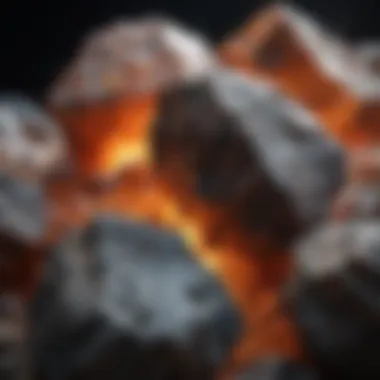
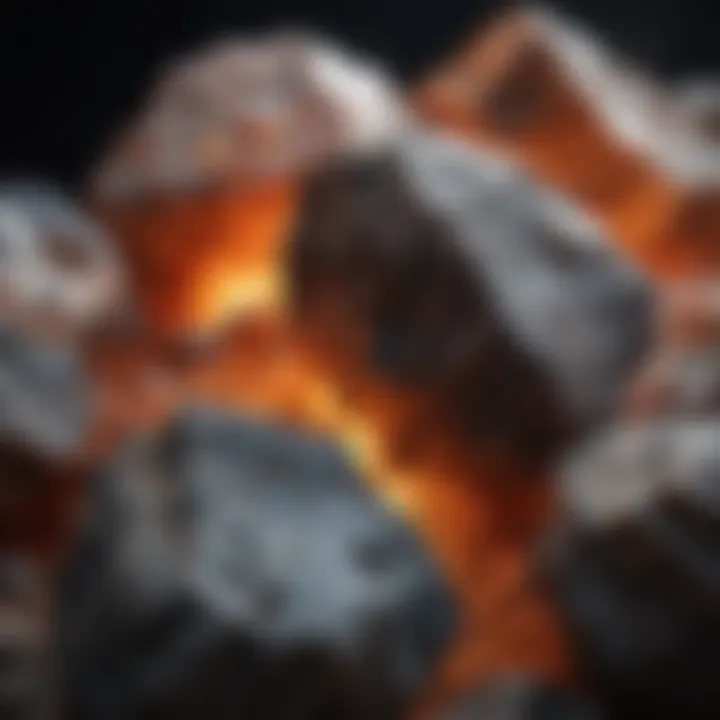
Protective Gear
To engage responsibly with ultraviolet light, equipping yourself with the appropriate protective gear is non-negotiable. Safety glasses are particularly vital; look for those designed specifically to filter out UV rays. Regular sunglasses often fall short in this aspect, which could leave your eyes vulnerable during UV observations. It's kind of like showing up to a gunfight with a butter knife—you need the right tools.
Wearing long-sleeved clothing can also add an extra layer of defense. Fabrics with high UPF ratings are ideal, as they can impede the penetrating rays from reaching your skin. A simple rule of thumb? Opt for darker colors—these typically absorb more light rather than reflecting it back to the skin.
Lastly, where feasible, utilizing UV shields or filters for larger equipment can help in controlling exposure. After all, it's always better to be safe than sorry; investing a little in your safety gear pays dividends in the long run.
Minimizing UV Exposure
Even with protective gear, awareness about minimizing exposure is key to maintaining health while enjoying the wonders of UV light. First off, timing can make a substantial difference. Engaging with UV light during the earlier hours of the day when the sun's rays are not at their peak isn’t a bad idea, especially if you're testing outdoors.
Another effective strategy is to establish a dedicated work area indoors, shielded from direct UV exposure. This not only helps in controlling environmental variables but also ensures that you’re not inadvertently absorbing rays. Some collectors and researchers have taken to using UV lamps in controlled setups, allowing for meticulous study while drastically reducing exposure risk.
To add a touch of levity, think of it like hosting a dinner party: you want to keep a good balance between your guests (the minerals) and the atmosphere (the UV light exposure).
Future Directions in UV Light Research
In an era where scientific inquiry continues to widen, the future directions in research concerning ultraviolet light's impact on minerals stand as notable and exciting avenues. This exploration plays a crucial role in not just increasing our scientific knowledge but also enhancing practical applications that can benefit many fields like geology, mineralogy, and even industrial applications.
Advancements in UV Technology
Recent advancements in UV technology deserve a closer look, as they hold the key to unlocking new insights about minerals. The development of more sophisticated UV light sources—such as light-emitting diodes (LEDs) optimized for specific wavelengths—has improved the way we study fluorescence. With reduced energy consumption and increased durability, these LEDs allow researchers and collectors alike to conduct studies that were previously untenable.
Moreover, advancements in spectroscopic techniques enable precise measurements of a mineral's interaction with UV light. This facilitates a deeper understanding of elemental composition and structural characteristics. For example, using portable spectrometers, mineral collectors can analyze specimens in real-time during fieldwork, drastically enhancing their capability to identify and later verify the desired minerals.
Implications for Mineralogy
The implications of ongoing research into UV light's effects on minerals are manifold. One of the most significant factors is the potential to discover new fluorescent minerals. As researchers continue to experiment with varied environments that promote fluorescence under UV light, the chances of uncovering previously unknown minerals increase. This can vastly enrich collections and lead to greater scientific understanding of mineral properties.
Additionally, studies related to UV-induced alterations in mineral structures can enlighten our understanding of geological processes. For instance, the way certain minerals react to prolonged UV exposure can reveal insights into historical environmental conditions and the conditions under which these minerals were formed. Minerals like calcite and fluorite exhibit changes that tell stories of past geological events, enabling scientists to piece together Earth’s history.
"The study of ultraviolet light in mineralogy not only enhances identification processes but also opens up opportunities for innovative uses of minerals in technology."
In summary, future explorations centered around ultraviolet light will continue to carve out new niches within mineralogical research. As technology advances, it encourages both passion in hobbyist collections and the academic pursuit of understanding our planet better.
Ending
The exploration of ultraviolet light's relationship with minerals is not merely a scientific curiosity; it’s an essential chapter in the broader narrative of geology and mineralogy. Throughout this article, we’ve examined how UV light illuminates the hidden characteristics of minerals, facilitating both identification and understanding. It fosters a deeper appreciation for the intricate world of crystals and stones, which can often go unnoticed under regular light conditions.
Summary of Key Insights
Many essential points arise from our discussions on ultraviolet light's role within mineralogy. First and foremost, fluorescence serves as a remarkable diagnostic tool that aids mineral collectors and geologists alike. Notable fluorescent minerals like Fluorite, Smithsonite, and Calcite exemplify this phenomenon, showcasing vibrant colors when exposed to UV light. Moreover, the identification techniques discussed can streamline fieldwork and enhance the educational experience around mineral studies.
- Fluorescent Characteristics: The ability of certain minerals to emit visible light upon UV exposure highlights significant differences in mineral composition.
- Field Techniques: The practical applications of UV light create a bridge between scientific research and hobbyist collection, making the study of minerals accessible to everyone from academic scholars to casual enthusiasts.
This knowledge empowers individuals, placing tools in their hands that can enhance both their studies and collections.
The Importance of Continued Study
As we navigate forward, the need for ongoing research into UV light's interaction with minerals becomes apparent. Science is always evolving; what is known today may just be the tip of the iceberg. Continued investigation holds numerous benefits:
- Understanding Mineral Composition: With technology continually advancing, new methods can provide insights into the atomic structure of minerals, expanding our knowledge exponentially.
- Environmental Monitoring: Research into how UV light influences mineral degradation can inform practices to preserve geological sites and artifacts, crucial for conservation efforts.
- Educational Advancements: Incorporating UV studies in academic syllabi can captivate new generations, promoting a passion for geology and mineralogy that culminates in informed stewardship of Earth’s resources.



